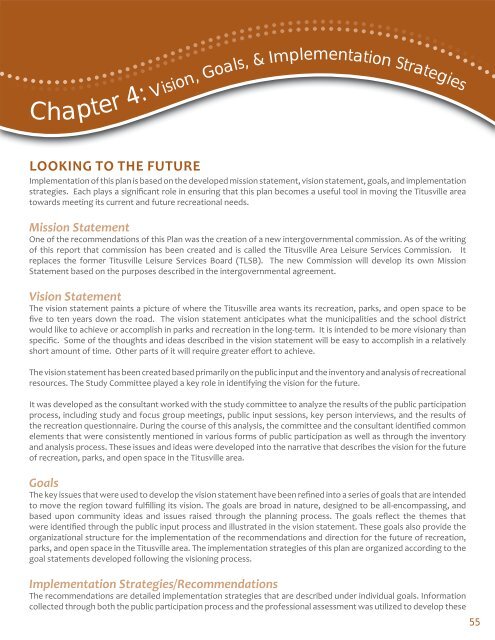2013 RECREATION, PARK, and OPEN SPACE ... - Titusville City Hall
2013 RECREATION, PARK, and OPEN SPACE ... - Titusville City Hall
2013 RECREATION, PARK, and OPEN SPACE ... - Titusville City Hall
Create successful ePaper yourself
Turn your PDF publications into a flip-book with our unique Google optimized e-Paper software.
Chapter 4: Vision, Goals, & Implementation Strategies<br />
LOOKING TO THE FUTURE<br />
Implementation of this plan is based on the developed mission statement, vision statement, goals, <strong>and</strong> implementation<br />
strategies. Each plays a significant role in ensuring that this plan becomes a useful tool in moving the <strong>Titusville</strong> area<br />
towards meeting its current <strong>and</strong> future recreational needs.<br />
Mission Statement<br />
One of the recommendations of this Plan was the creation of a new intergovernmental commission. As of the writing<br />
of this report that commission has been created <strong>and</strong> is called the <strong>Titusville</strong> Area Leisure Services Commission. It<br />
replaces the former <strong>Titusville</strong> Leisure Services Board (TLSB). The new Commission will develop its own Mission<br />
Statement based on the purposes described in the intergovernmental agreement.<br />
Vision Statement<br />
The vision statement paints a picture of where the <strong>Titusville</strong> area wants its recreation, parks, <strong>and</strong> open space to be<br />
five to ten years down the road. The vision statement anticipates what the municipalities <strong>and</strong> the school district<br />
would like to achieve or accomplish in parks <strong>and</strong> recreation in the long-term. It is intended to be more visionary than<br />
specific. Some of the thoughts <strong>and</strong> ideas described in the vision statement will be easy to accomplish in a relatively<br />
short amount of time. Other parts of it will require greater effort to achieve.<br />
The vision statement has been created based primarily on the public input <strong>and</strong> the inventory <strong>and</strong> analysis of recreational<br />
resources. The Study Committee played a key role in identifying the vision for the future.<br />
It was developed as the consultant worked with the study committee to analyze the results of the public participation<br />
process, including study <strong>and</strong> focus group meetings, public input sessions, key person interviews, <strong>and</strong> the results of<br />
the recreation questionnaire. During the course of this analysis, the committee <strong>and</strong> the consultant identified common<br />
elements that were consistently mentioned in various forms of public participation as well as through the inventory<br />
<strong>and</strong> analysis process. These issues <strong>and</strong> ideas were developed into the narrative that describes the vision for the future<br />
of recreation, parks, <strong>and</strong> open space in the <strong>Titusville</strong> area.<br />
Goals<br />
The key issues that were used to develop the vision statement have been refined into a series of goals that are intended<br />
to move the region toward fulfilling its vision. The goals are broad in nature, designed to be all-encompassing, <strong>and</strong><br />
based upon community ideas <strong>and</strong> issues raised through the planning process. The goals reflect the themes that<br />
were identified through the public input process <strong>and</strong> illustrated in the vision statement. These goals also provide the<br />
organizational structure for the implementation of the recommendations <strong>and</strong> direction for the future of recreation,<br />
parks, <strong>and</strong> open space in the <strong>Titusville</strong> area. The implementation strategies of this plan are organized according to the<br />
goal statements developed following the visioning process.<br />
Implementation Strategies/Recommendations<br />
The recommendations are detailed implementation strategies that are described under individual goals. Information<br />
collected through both the public participation process <strong>and</strong> the professional assessment was utilized to develop these<br />
55


